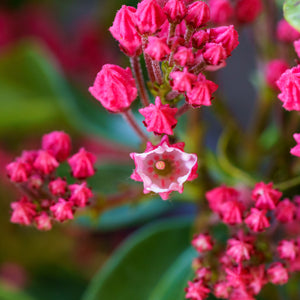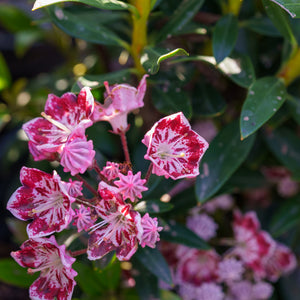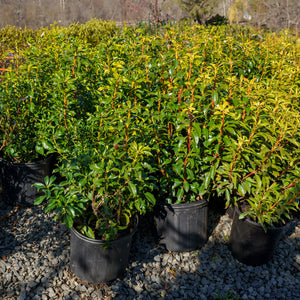The Mountain Laurel Guide
Mountain laurel, with its botanical grace and natural allure, stands as a testament to the enchanting beauty found in native landscapes. Flourishing in the wild and captivating gardeners alike, the mountain laurel, scientifically known as Kalmia latifolia, offers a majestic presence and unrivaled elegance. This evergreen shrub, native to the eastern United States, paints landscapes with a palette of delicate blooms and glossy foliage, creating a tranquil woodland retreat or becoming a standout feature in gardens. As we delve into the realm of mountain laurel, we explore not only its captivating aesthetics but also the secrets to cultivating and caring for this botanical gem, allowing its timeless presence to grace your outdoor haven.

About
Discover the captivating world of mountain laurel (Kalmia latifolia), a mesmerizing evergreen shrub that graces landscapes with its innate charm and ecological significance. Native to the eastern United States, mountain laurel is a botanical marvel celebrated for its gracefully arching branches and clusters of small, fragrant flowers that range from pristine white to delicate shades of pink and lavender, creating a visual symphony throughout the growing season. With a diverse array of more than 30 recognized species, mountain laurel becomes an integral part of the floral tapestry in temperate and subtropical regions, embodying natural elegance.
Beyond its aesthetic allure, mountain laurel plays a vital role in supporting local ecosystems. Its nectar-rich flowers serve as a magnet for essential pollinators, including bees, butterflies, and hummingbirds. The dense foliage and intricate branching structure provide shelter for small birds and insects, contributing to the overall biodiversity of the garden and fostering a harmonious ecosystem.
Mountain laurel showcases remarkable adaptability to various soil types and environmental conditions. Thriving in both full sun and partial shade, this evergreen beauty adds versatility to different garden settings. With a moderate growth rate and manageable size, mountain laurel proves suitable for diverse landscaping applications, from hedging and borders to standalone features, making it a versatile and resilient addition to any outdoor space.
As we explore popular species within the mountain laurel family, such as the glossy-leaved Kalmia latifolia and fragrant varieties, we delve into the unique characteristics that contribute to the plant's distinct appeal. Whether positioned as a striking focal point in a garden, planted in groups to create a natural hedge, or incorporated into mixed borders, mountain laurel imparts an air of elegance and beauty to any landscape.
By selecting and nurturing mountain laurel in your outdoor space, you not only enhance its aesthetic appeal but actively contribute to the preservation of this remarkable shrub and the biodiversity it supports. Embrace the diversity and resilience of mountain laurel, and cultivate a garden that harmonizes with the rhythmic beauty of nature.
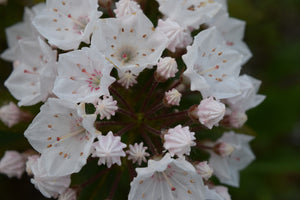
Planting
The exquisite mountain laurel demands thoughtful consideration during the planting process to ensure its successful establishment and thriving growth. Here are indispensable guidelines for planting and caring for mountain laurel:
Soil Preparation: Mountain laurel thrives in well-draining soil enriched with organic matter. It prefers slightly acidic soil with a pH between 5.0 and 6.5. To create an optimal planting environment, prepare the site by loosening the soil and incorporating generous amounts of compost or organic matter. This not only enhances drainage but also fosters fertility, providing a nutrient-rich foundation crucial for the mountain laurel's vitality.
Sunlight Requirements: Mountain laurel plants flourish when exposed to dappled sunlight or partial shade. While they can tolerate some shade, it's advisable to prioritize planting locations that receive at least six hours of direct sunlight each day. In regions with hot and dry climates, mountain laurel's adaptability to varying light conditions ensures successful growth and the development of its distinctive blooms.
Adequate Watering: Ensuring adequate and consistent watering, especially during the initial stages of establishment, is crucial for the mountain laurel. Deeply water the plant immediately after planting and continue with regular irrigation throughout the first year. Adjust the watering frequency, aiming for deep and thorough watering once or twice a week, depending on natural rainfall and soil moisture levels. Caution is needed to avoid overwatering, which can lead to root rot.
Mulching for Moisture and Temperature Control: Applying a layer of organic mulch around the base of the mountain laurel provides multiple benefits. Mulch helps conserve soil moisture, suppresses weed growth, and regulates soil temperature. Use materials like wood chips, bark, or compost as mulch. Maintain a gap of a few inches between the mulch and the trunk to prevent excess moisture accumulation around the plant's base.
Pruning Practices: Mountain laurel typically requires minimal pruning to maintain a strong and balanced structure. Focus on removing any dead, damaged, or crossing branches. The ideal time for pruning is during late winter or early spring when the plant is dormant, just before new growth emerges. This ensures minimal stress on the mountain laurel, promoting healthy development and a well-formed structure.
By adhering to these essential planting and care guidelines, you can facilitate the successful establishment and robust growth of your mountain laurel. Implementing these practices ensures the longevity and beauty of your landscape, allowing the mountain laurel to thrive and grace your outdoor space with its enchanting presence for years to come.
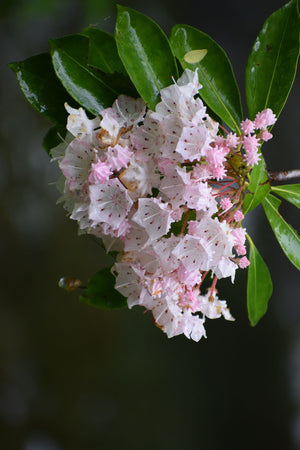
Care
To ensure the optimal growth and enduring beauty of your Mountain Laurel, specific care practices are essential. Here are comprehensive guidelines for the care of Mountain Laurel, enriching your garden with its captivating allure:
Watering Wisdom: During the growing season, provide moderate and consistent watering for your mountain laurel. Aim for approximately one inch of water per week, adjusting based on natural rainfall. It is crucial to water deeply and thoroughly, fostering robust root development. Avoid shallow watering, as it can induce stress and dehydration. In periods of drought or elevated temperatures, additional watering may be necessary to maintain adequate soil moisture.
Pruning Precision: Mountain laurel generally requires minimal pruning, but selective care enhances its overall health and aesthetic appeal. Remove any dead or damaged branches to preserve the plant's vitality and appearance. Shaping can be employed to achieve the desired size and form. Optimal pruning time is during late winter or early spring, before the onset of new growth. Use clean, sharp pruning tools to minimize the risk of harm. Deadheading spent flowers can stimulate new growth, potentially triggering a second blooming and contributing to a prolonged flowering season.
Fertilizing Finesse: Fertilization plays a pivotal role in promoting vibrant growth and abundant flowering in mountain laurel. Apply a balanced, slow-release fertilizer in the spring or early summer, following the recommended application rates and timing specified by the manufacturer. Exercise caution to avoid over-fertilizing, as it can negatively impact the plant's root system. When uncertain, opt for a conservative approach and use less fertilizer, ensuring the health and longevity of your mountain laurel.
Soil and Sunlight Harmony: Mountain laurel thrives in well-drained, moist soil and revels in full exposure to sunlight. While it exhibits tolerance to diverse soil types, ensuring optimal drainage is essential for its well-being. Mulching around the base of the plant contributes to moisture retention and regulates soil temperature, creating a conducive environment for healthy growth.
Pests and Diseases Vigilance: Though generally resilient, mountain laurel can face challenges from pests like aphids, birch borers, and leaf miners. Vigilance is key—regularly monitor your plants for signs of damage or disease. Swift action with appropriate insecticides or fungicides, when necessary, will help safeguard the health and vitality of your mountain laurel.
By adhering to these holistic care guidelines, your mountain laurel will flourish, becoming a perennial source of beauty, shade, and majesty in your garden for many years to come.
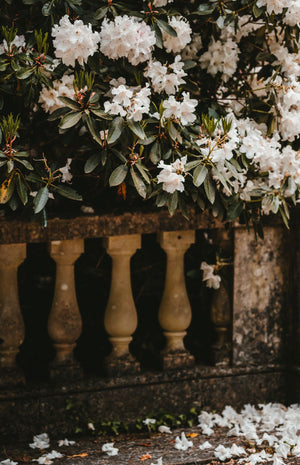
How To Use
Harness the graceful and versatile nature of mountain laurel to enrich your landscape. Tailor its characteristics to your advantage with these insightful recommendations:
Elegance Unveiled: Make a striking statement by featuring mountain laurel as a stunning focal point in your garden. Plant a cluster of these captivating shrubs in an open area to showcase their delicate form and enchanting foliage. Alternatively, create a diverse display by mixing and matching different mountain laurel varieties, allowing your garden to evolve beautifully throughout the seasons.
Bordering Beauty: Define the edges of your garden beds with the elegance of mountain laurel. Their compact and bushy growth makes them ideal for creating borders that bring a touch of refinement to your outdoor space. Allow them to weave a tapestry of color and texture along pathways or around other garden features, enhancing the overall aesthetic.
Vibrant Hedges: Transform utilitarian features into eye-catching elements by planting mountain laurel as hedges. Their dense growth habit provides not only privacy but also a burst of color. Regular shaping maintains a neat appearance, letting these vibrant hedges become living boundaries that redefine the aesthetics of your garden with their evergreen charm.
Container Brilliance: Embark on a journey of creative container gardening by cultivating mountain laurel in pots or containers. This allows you to introduce bursts of color to patios, decks, or balconies, enhancing your outdoor space. Experiment with various container sizes and shapes to customize your setting, providing flexibility and versatility.
Companion Planting Harmony: Combine the beauty and functionality of mountain laurel by using them as companion plants. Their vibrant foliage and flowers complement a variety of other plants. Integrate mountain laurel into mixed borders or group them with perennials to create visually pleasing and ecologically supportive plant communities, fostering a harmonious garden ecosystem.
Whether you're seeking a focal point, a border, a hedge, or a potted masterpiece, mountain laurel brings elegance and versatility to your landscape. Consider its moderate size, delightful blooms, and adaptability when planning your garden. With mountain laurel, you're not just landscaping; you're crafting a masterpiece that evolves with the seasons, adding a touch of sophistication to your outdoor haven.
Conclusion
In the realm of landscaping, mountain laurel stands out as a versatile and enchanting shrub, offering a symphony of colors, forms, and practical uses for your outdoor sanctuary. With its graceful demeanor and adaptability, mountain laurel adds a touch of refined beauty to various garden settings, becoming an integral part of the narrative you weave in your garden.
From the delicate blooms of spring, reminiscent of nature's awakening, to the vibrant foliage of summer and the warm tones of fall, mountain laurel paints a living canvas that evolves with the seasons, ensuring your landscape is a perpetual work of art. The ever-changing hues and intricate foliage contribute to the dynamic character of your outdoor haven.
Beyond its visual allure, mountain laurel plays multiple roles in your garden. Whether employed as a standalone focal point, an elegant border, a vibrant hedge, or a potted masterpiece, this shrub brings both aesthetics and practicality. It crafts privacy, defines spaces, and enhances the overall charm of your garden, proving that beauty can indeed serve a purpose in the outdoor landscape.
A testament to its versatility, mountain laurel makes excellent companions to a variety of plants. Its ability to thrive in mixed borders or complement other perennials showcases its compatibility in diverse plant communities. With mountain laurel as part of your garden ensemble, you're not merely cultivating plants; you're nurturing a harmonious ecosystem where each element plays a unique role in the natural symphony.
Embrace the ever-changing melody of your garden with mountain laurel as a key player. Its resilience and ability to adapt ensure that your landscape remains dynamic, responding to the rhythm of the seasons. By incorporating mountain laurel, you're creating an outdoor space that resonates with life, color, and the subtle charm of nature.
In the realm of garden design, mountain laurel is not just a shrub; it is a living note in the melody of your landscape. With thoughtful planting, care, and creative deployment, this versatile shrub can be the crescendo that elevates your outdoor space to a masterpiece. Nurture your garden with the dedication it deserves, and let mountain laurel be the timeless refrain that brings you joy for years to come.

